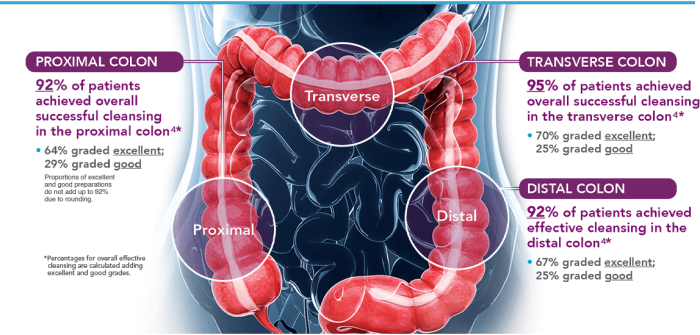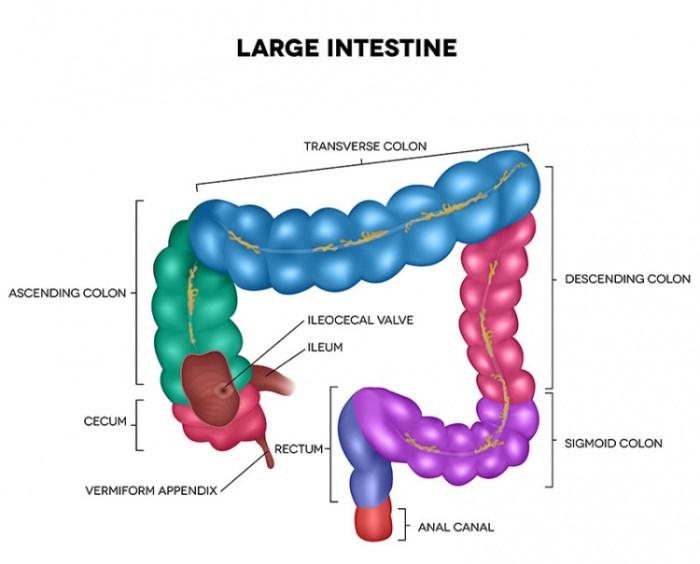Correctly label the following parts of the large intestine. – Correctly labeling the anatomical regions of the large intestine is crucial for understanding its structure and function. This guide provides a comprehensive overview of the large intestine’s anatomy, histology, functions, and clinical significance, empowering readers with a thorough understanding of this vital organ.
The large intestine, also known as the colon, is the final segment of the digestive tract responsible for absorbing water and electrolytes, forming and storing stool, and eliminating waste products.
Anatomical Regions of the Large Intestine

The large intestine, also known as the colon, is a part of the digestive system responsible for absorbing water, electrolytes, and vitamins from undigested food. It extends from the ileocecal valve to the rectum and anus. The large intestine can be divided into several anatomical regions, each with its own distinct functions:
- Cecum:The cecum is a pouch-like structure located at the junction of the small and large intestines. It receives undigested food from the ileum and houses the appendix, a small, finger-like projection with no known function.
- Ascending colon:The ascending colon is the first part of the large intestine that extends upward from the cecum on the right side of the abdomen. Its primary function is to absorb water and electrolytes from the undigested food.
- Transverse colon:The transverse colon is the longest part of the large intestine and extends across the abdomen from the ascending colon to the descending colon. It is responsible for further absorption of water and electrolytes.
- Descending colon:The descending colon is located on the left side of the abdomen and extends downward from the transverse colon. It continues to absorb water and electrolytes and stores waste products before they are eliminated.
- Sigmoid colon:The sigmoid colon is the final part of the large intestine and is located in the lower left quadrant of the abdomen. It connects the descending colon to the rectum and serves as a reservoir for waste products.
- Rectum:The rectum is a short, straight segment of the large intestine that connects the sigmoid colon to the anus. It stores waste products before they are expelled.
- Anus:The anus is the final opening of the digestive tract and is responsible for expelling waste products from the body.
The table below summarizes the anatomical regions of the large intestine, their locations, and their functions:| Region | Location | Function ||—|—|—|| Cecum | Junction of small and large intestines | Receives undigested food and houses the appendix || Ascending colon | Right side of abdomen | Absorbs water and electrolytes || Transverse colon | Across the abdomen | Absorbs water and electrolytes || Descending colon | Left side of abdomen | Absorbs water and electrolytes, stores waste products || Sigmoid colon | Lower left quadrant of abdomen | Reservoir for waste products || Rectum | Connects sigmoid colon to anus | Stores waste products || Anus | Final opening of digestive tract | Expels waste products |
Histological Features of the Large Intestine

The large intestine is composed of four main layers:
- Mucosa:The mucosa is the innermost layer of the large intestine and is responsible for absorbing water, electrolytes, and vitamins. It is lined with a layer of simple columnar epithelium and contains numerous goblet cells that secrete mucus to protect the lining of the intestine.
- Submucosa:The submucosa is a layer of connective tissue that supports the mucosa. It contains blood vessels, lymphatic vessels, and nerves.
- Muscularis externa:The muscularis externa is a layer of smooth muscle that surrounds the submucosa. It is responsible for propelling waste products through the large intestine.
- Serosa:The serosa is the outermost layer of the large intestine and is a thin layer of connective tissue that covers the muscularis externa. It is lined with mesothelial cells and secretes a serous fluid that reduces friction between the intestine and surrounding organs.
The image below shows a cross-section of the large intestine, highlighting its histological features:[Insert image of a cross-section of the large intestine here]The histological features of the large intestine are essential for its function. The mucosa is responsible for absorbing nutrients and water, while the submucosa supports the mucosa and provides a pathway for blood vessels and nerves.
The muscularis externa propels waste products through the large intestine, and the serosa reduces friction between the intestine and surrounding organs.
FAQ Overview: Correctly Label The Following Parts Of The Large Intestine.
What are the main functions of the large intestine?
The large intestine’s primary functions include absorbing water and electrolytes, forming and storing stool, and eliminating waste products.
What are the common diseases and disorders of the large intestine?
Common diseases and disorders of the large intestine include diverticulitis, inflammatory bowel disease (IBD), and colorectal cancer.
How can I prevent large intestine-related diseases?
Preventive measures for large intestine-related diseases include maintaining a healthy diet, exercising regularly, and undergoing regular screenings.
